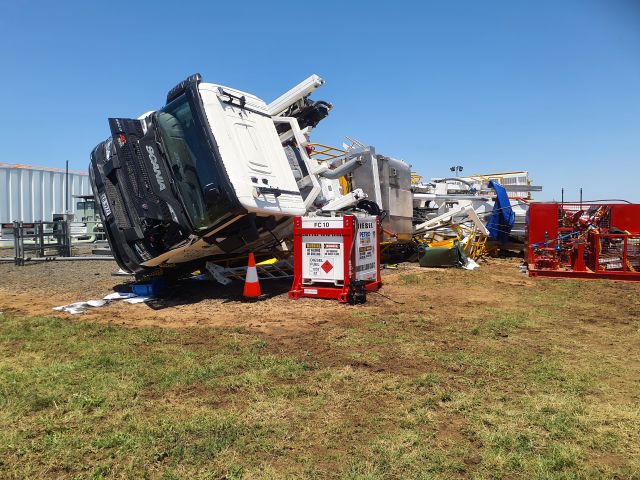
Petroleum & Gas Inspectorate | Alert | No.124 V 1 | 24 October 2025
Rig collapses during rig down operations on coal seam gas well
Summary
- A workover rig at a coal seam gas well has collapsed onto its side during rig down operations.
- While no one was hurt, multiple workers could have been seriously or fatally injured.
- Investigations are ongoing and initial learnings are outlined below.
Issue Explained
- The collapse occurred at the coal seam gas well during rig down operations, which involve removing the blow out preventor (BOP) from the wellhead and loading it onto its transport skid.
- Initial reports suggest the rig fell onto its side after it became unstable during the lifting operation of the BOP onto the transport skid.
- At the time of the collapse, numerous workers were in the vicinity of the fall zone and could have suffered serious or fatal injuries.
Learnings
- Relevant factors for any rig set up include:
- Understanding and accommodating ground conditions.
- Understanding the forces applied during lifting and slewing operations, including consideration of operational loads.
- Ensuring stabilisation systems are fit for purpose and setup procedures properly followed.
- An assessment of the ground conditions that the outriggers or stabilisers are to be positioned on, must be made prior to commencing lifting operations and re-assessed if events occur that may change these conditions (such as weather events). Factors affecting the ability of the ground to provide adequate support include:
- the presence of water (including when mixed with the soil as mud, and where it is present under the surface (e.g. underground springs or streams))
- the type of ground (e.g. clay, sand, rock or a mixture)
- backfilled ground that was previously an excavation or trench
- cavities or penetrations in the ground that have been covered but still exist
- continued operation of the rig in one location (e.g. the outrigger pads may sink).
- Operators are reminded of the importance of ensuring adequate ground bearing capacity.
- The ground’s bearing capacity must always be greater than the maximum pressure exerted by the rig’s outriggers or stabilisers.
- If the ground is not strong enough, control measures must be implemented — such as increasing the size of outrigger pads to spread the load or improving ground strength through earthworks or reinforcement before operations begin.
- Operators should review rig stability and operational procedures and strengthen stability controls during operations in accordance with the rig’s original equipment manufacturer (OEM) advice.
- Reassess safe working loads, rig stability calculations (including dynamic load factors), and Standard Operating Procedures (SOPs) for slewing operations that involve both the rig’s draw works and any mechanical assistance (e.g. loaders or cranes).
- Confirm that all operations stay within the rig’s designed stability limits under all load conditions.
- Operators should also review and enhance the controls used to keep the rig within its safe stability range during lifts and consider higher-order controls (engineering and above) to prevent unintended movement or drift that could cause instability or collapse.
Investigations are ongoing and further information may be published as it becomes available. The information in this publication is what is known at the time of writing.
We issue Safety Notices to draw attention to the occurrence of a serious incident, raise awareness of risks, and prompt assessment of your existing controls.
References and further information
- Petroleum and Gas (Production and Safety) Act 2004
- Petroleum and Gas (Safety) Regulation 2018
- Mobile crane - Code of Practice 2024 – Workplace Health and Safety Queensland
Contact: gasSafe@rshq.qld.gov.au
Issued by Resources Safety & Health Queensland
Placement: Place this announcement on noticeboards and ensure all relevant people in your organisation receive a copy.
Find more safety notices
Search the hazards database


